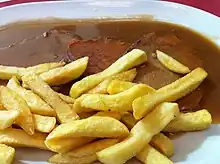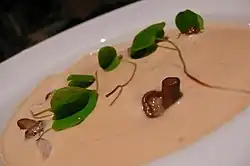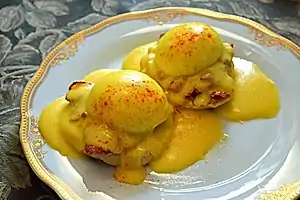In French cuisine, the mother sauces (French: sauces mères), also known as grandes sauces in French, are a group of sauces upon which many other sauces – "daughter sauces" or petites sauces – are based. Different sets and classifications of mother sauces have been proposed since at least the early 19th century.[1]
The most common list of mother sauces in current use is attributed to chef Auguste Escoffier[2][3][4][5] and based on his seminal cookery book Le guide culinaire:[6]
- Béchamel sauce: White sauce, based on milk thickened with a white roux.
- Espagnole sauce: Brown sauce based on a brown stock reduction, and thickened with a brown roux. Ingredients typically include roasted bones, bacon, and tomato (puréed or fresh).
- Tomato sauce (sometimes Tomate or Tomat): As well as tomatoes, ingredients typically include carrots, onion, garlic, butter, and flour, plus pork belly and veal broth.
- Velouté sauce: Light coloured sauce, made by reducing clear stock (made from un-roasted bones) and thickened with a white roux. Velouté is French for "velvety".
- Mayonnaise sauce: Cold emulsion of egg yolk, oil, and lemon juice or vinegar.
The original French editions of Le guide culinaire did not include Hollandaise as a grande sauce,[7] but separately described mayonnaise—a cold emulsion of egg yolk with oil and vinegar—as a mother sauce for cold sauces; this was not included in the English edition.[6]
History
The concept of mother sauces predated Escoffier's classification by at least 50 years; in 1844, the French magazine Revue de Paris reported:
Oui ne savez-vous pas que la grande espagnole est une sauce-mère, dont toutes les autres préparations, telles que réductions, fonds de cuisson, jus, veloutés, essences, coulis, ne sont, à proprement parler, que des dérivés?
Don’t you know that the grand sauce Espagnole is a mother sauce, of which all the other preparations, such as reductions, stocks, jus, veloutés, essences, and coulis, are, strictly speaking, only derivatives?
— Les Fantaisies du Rocher de Cancale[8]
Different classifications of French sauces into mother and daughter sauces have been proposed by different chefs, varying in number and selection.
Classification by Marie Antoine Carême (1833)
In 1833, Marie Antoine Carême published a classification of French sauces in his reference cookbook L’art de la cuisine française au XIXe siècle ("The Art of French Cuisine in the 19th Century"). Instead of mother sauces, he called them Grandes et Petites sauces ("great and small sauces").[1]
In this cookbook, Carême defined a sauce classification and listed four grandes sauces:
Carême classified the following as petites sauces:[1]
Classification by Jules Gouffé (1867)
In 1867, the French chef and pâtissier Jules Gouffé published Le livre de cuisine comprenant la grande cuisine et la cuisine de ménage (The Cookbook Including Grand And Domestic Cooking).[9]
In this book, Gouffé listed twelve mother sauces. (He used both the terms grandes sauces and sauce mères).
- Espagnole Grasse (Fattier Espagnole)
- Espagnole Maigre (Leaner Espagnole)
- Velouté Gras (Fattier Velouté)
- Velouté Maigre (Leaner Velouté)
- Allemande (Velouté thickened with eggs)
- Béchamel à l’ancienne (Old Fashioned Béchamel)
- Béchamel de volaille (Poultry Béchamel)
- Béchamel maigre (Leaner Béchamel)
- Poivrade brune (Brown Poivrade)
- Poivrade Blanche (White Poivrade)
- Poivrade Maigre (Leaner Poivrade)
- Marinade
Classification by Auguste Escoffier (1903)
The pioneering chef Auguste Escoffier is credited with establishing the importance of Espagnole, Velouté, Béchamel and Tomate, as well as Hollandaise and Mayonnaise.[3][10] His book Le guide culinaire was published in 1903. The 1912 edition lists the "Grandes Sauces de base" as:[7]
- Espagnole
- Velouté
- Béchamel
- Tomate
Escoffier listed Hollandaise sauce as a daughter sauce in Le guide culinaire.[7] Mayonnaise was placed in the chapter on cold sauces, described as a mother sauce for cold sauces, and compared to Espagnole and Velouté.[7]
The 1907 English edition of Le guide culinaire, A Guide to Modern Cookery, listed five "basic sauces", including Hollandaise alongside the original four.[6] The English edition did not describe mayonnaise as a mother sauce.[6]
Daughter sauces
Many sauces, often referred to as daughter sauces, can be derived from mother sauces.[11][12]
Béchamel sauce
Béchamel is a milk-based sauce, thickened with a white roux and typically flavoured with onion, nutmeg, or thyme.
Derivations of béchamel
Espagnole sauce
Espagnole is a strong-flavoured brown sauce, made from a dark brown roux and brown stock—usually beef or veal stock—and tomatoes or tomato paste.
Derivations of espagnole
- Demi-glace
- Poivrade
- Grand veneur
- Bigarade
Velouté sauce
Velouté is light in colour, made by reducing clear stock (made from un-roasted bones), usually veal, chicken or fish stock, thickened with a white or blond roux. Velouté is the French word for "velvety".
Derivations of velouté
Tomato sauce
The sauce tomate described by Escoffier is a tomato sauce made with fatty salted pork breast, a mirepoix of carrots, onions and thyme, and white stock.
Derivations of tomato
- Bolognese
- Portugaise
- Milanaise
Hollandaise sauce
Hollandaise is a warm emulsion based on egg yolk and clarified butter, flavoured with lemon juice or vinegar.
Derivations of hollandaise
Mayonnaise
Mayonnaise is an emulsion of egg yolk and oil, served cold and flavoured with lemon juice, vinegar, and seasoning.
Derivations of mayonnaise
See also
- List of sauces
- Obe ata, a West African sauce used as a mother sauce
References
- 1 2 3 Carême, M Antonin; Fayot, Charles Frédéric Alfred; Plumery, Armand (1833). L'art de la cuisine française au dix-neuviême siêcle : traité élémentaire et pratique ... [The art of French cuisine in the nineteenth century: an elementary and practical treatise...] (in French). Paris : L'auteur [etc.]
- ↑ Lundberg, Donald E. (1965). Understand Cooking. Pennsylvania State University. p. 277.
- 1 2 Allen, Gary (2019). Sauces Reconsidered: Après Escoffier. Rowman & Littlefield. p. 52. ISBN 9781538115138.
- ↑ Ruhlman, Michael (2007). The Elements of Cooking: Translating the Chef's Craft for Every Kitchen. Simon and Schuster. p. 171. ISBN 9781439172520.
- ↑ "Do You Know Your French Mother Sauces?". Thekitchn.com. Archived from the original on 12 November 2020. Retrieved 8 December 2020.
- 1 2 3 4 Escoffier, Auguste (1907). A guide to modern cookery. W. Heinemann.
- 1 2 3 4 Escoffier, Auguste (1912). Le Guide Culinaire: aide-mémoire de cuisine pratique (3e édition) [The Culinary Guide: practical kitchen cheat sheet (3rd edition)] (in French). Archived from the original on 21 October 2020. Retrieved 8 December 2020.
{{cite book}}:|website=ignored (help) - ↑ "Les Fantaisies du Rocher de Cancale" [The Fancies of Cancale]. Gallica (in French). Revue de Paris. May 1844. p. 380. Archived from the original on 25 October 2019. Retrieved 8 December 2020.
- ↑ Gouffé, Jules (1867). Le livre de cuisine: comprenant la cuisine de ménage et la grande cuisine [The Cookbook Including Grand And Domestic Cooking] (in French). Archived from the original on 27 October 2020. Retrieved 8 December 2020.
{{cite book}}:|website=ignored (help) - ↑ Peterson, James (2017). Sauces: Classical and Contemporary Sauce Making, Fourth Edition. Houghton Mifflin Harcourt. p. 17. ISBN 9780544819832.
- ↑ "Mother and Daughter: the Extended Family of Sauces". www.finedininglovers.com. Archived from the original on 24 October 2020. Retrieved 8 December 2020.
- ↑ "Les sauces mères et leurs dérivés" [The mother sauces and their derivatives] (PDF). Académie de Rouen (in French). Archived (PDF) from the original on 12 December 2020. Retrieved 8 December 2020.


.jpg.webp)


.jpg.webp)